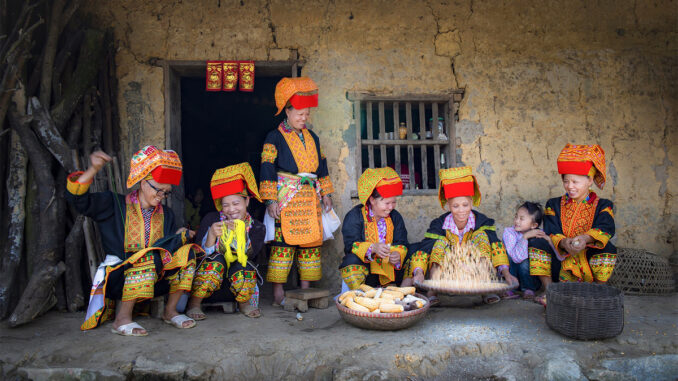
LANG SON – Visitors to Mau Son will experience the colorful life of the Dao, from the way of eating, sticky rice to traditional costumes and rituals.
Mau Son has 3 ethnic groups living together: Dao, Tay, Nung, in which the Dao accounts for over 98% of the population. From the past until now, the Dao in Mau Son commune, a commune in the border region III, always retain cultural identity.
Photo set “Sticky life of the Dao in Mau Son” by photographer Nguyen Son Tung (Lang Son city), made. He is often referred to as Tung “Dao” by his friends because of his imprint through photo stories about portraits, costumes and the traditional lifestyle of the Dao ethnic group.

The Dao eat two main meals a day, in the morning before going to work and at night, and for lunch they usually eat in the fields. The main food is glutinous rice, with each type having different processing methods and tools.
They use the mill and crushed their feet to process the grain into rice; Use a stone mill to mill corn. Rice cooked into rice or cooked porridge depending on each person, each family; Corn is broken into small grains and cooked into rice, porridge or cakes.
Especially with meat, they also have a unique salted hanging meat dish, this dish is served with the strange young posterior leaves and does not get sick.

After the Dao people harvest, they are dried in the kitchen upstairs, keep dry, avoid termites, corn stains on the kitchen smoke discolored and has a very characteristic taste.

Dao women’s attire is a four-body long dress that breaks down the chest. The inside of the shirt is embroidered with patterns, with silver stars, decorated with beads and a white belt embroidered with black tree branches. The side is wearing a silver pendant.
Dao women are very colorful. Clothes and towels are embroidered with color thread, using motifs of birds, pine trees … Such a garment must be hand-embroidered for months or years to complete.

“The daily use of traditional clothing is still high frequency, but mainly the elderly. It is worrying that the artisans know how to embroider, weave and sew traditional costumes are less and less, while the materials for embroidering and weaving are also increasingly scarce ”, shared Mr. Tung.

Men Dao eats simpler. Black shirt with five-color tassels for decoration. Wide leggings tied with hemp rope with coins to hold. Head with turban or more simply tie a scarf.

In the past, Dao men and women often married before the age of twenty. Now the marriage is done at the right age that the Marriage Law stipulates as other ethnic groups. A wedding consists of a solicitation ceremony (nôm Nham), a fortune-telling ceremony (a couple’s date of birth to compare their age), a commitment agreement, and a wedding ceremony. When it comes to the custom of getting married, it is impossible not to mention the love song singing and the sound of Pí’s trumpet picking up the bride.
On the wedding day, everyone is dressed in traditional costumes. The groom’s family comes to pick up the bride from a dream, while the bride prepares furniture to go to her husband’s house. When departing, the bride wears national costumes, approaching the gate of the groom’s house, the girl’s family will stop to change for the bride.
Wedding day is also a gathering day for boys and girls, creating a very unique and exciting scene.

One of the traditional musical instruments of the Dao is Pí Lè (in Tay, Nung called Pí lè, in Dao language called Nom dè). Ken is used by the Dao on occasions such as worshiping rice god, forest god, weddings, Tet holidays. The sound of the trumpet is like the words of people’s hearts to heaven and earth, mountains and forests, words of love-seeking couples, words of children with parents.
The trumpet consists of 3 parts: the blowing head, the trumpet body and the trumpet, which can play 72 different melodies, as in a wedding ceremony, the melody is cheerful and bustling; And the funeral is young and boring. The person blowing in the nose, pushing the breath through the mouth through the blowing head impact on the small holes in the body of the trumpet. When performing, in each different ritual, the trumpeter applies the techniques of vibrating, pawning, coordinating with fingers, clawing on the body of the trumpet to create suitable flying sounds.

Ancestor worship is an important custom of Dao families. They worship their ancestors up to nine generations, but directly three generations, including parents, grandparents and grandparents. Ancestor worship is also shown through many rituals such as funeral, algae tomb, full moon worship in July, Lunar New Year worship or offering new rice.
The Dao people are originally residents in the field and farming, so the rituals are plentiful, such as worshiping on the first day of rice cultivation. This is one of the important rituals, praying to God Nong to bless the good crops. The new rice ceremony is made after the harvest to give thanks to the ancestors, so that the Farmer can bless the rich crops.
In funeral rituals, the Dao believe that the dry funeral (photo) is a ceremony to release the dead person’s soul to their ancestors, their roots, hoping that the deceased’s soul will be saved, and rest in peace with the ancestors. The dry ritual is performed at home, one month after family members have buried it.
vnexpress
